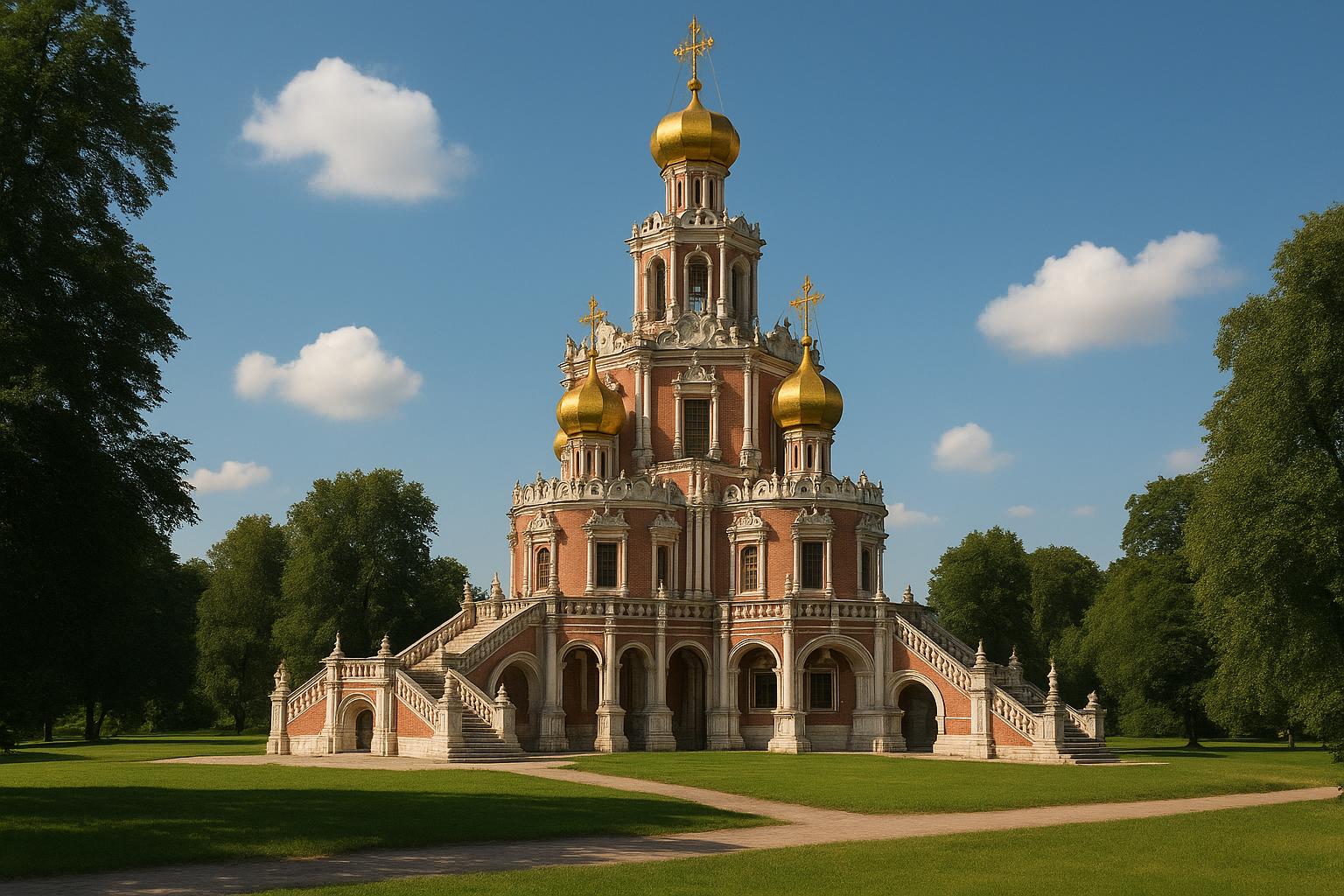Overview
The Church of the Intercession at Fili is an architectural gem located in Moscow, Russia. It stands as a striking example of Naryshkin Baroque, a style that emerged in the late 17th century. This church, commissioned by the influential noble Lev Naryshkin, represents the changing tastes of the Russian aristocracy during this era.
Historical Context
Constructed between 1690 and 1694, the church sits on the former estate of the Naryshkin family in the village of Fili, now part of Moscow. Lev Naryshkin, uncle to Peter the Great, initiated the construction after a military victory. The period marked a transition from the traditional Russian architectural designs to a more Western-influenced style, paving the way for broader cultural shifts in Russia.
The Influence of Lev Naryshkin
Lev Naryshkin was a significant figure in Russian history, not only due to his family ties with the czar’s family but also because of his role in the cultural transformation that swept through Russia at the time. His decision to commission the Church of the Intercession was indicative of a broader shift among the Russian elite, who began to embrace architectural styles more commonly associated with Western Europe. This reflected an openness to new ideas and an eagerness to integrate these into Russian culture, setting the stage for more expansive cultural reforms initiated later by Peter the Great.
The Naryshkin Place in Russian Aristocracy
The Naryshkin family’s prominence in Russian aristocracy allowed them to influence cultural and architectural trends significantly. Their connection with the royal family, particularly through the marriage of Tsar Alexis to Lev Naryshkin’s sister Natalie, solidified their position of power. This relationship facilitated the flow of Western architectural ideas into Russia, with the Church of the Intercession standing as a physical embodiment of this cultural exchange.
Architectural Features
The Church of the Intercession at Fili exemplifies the harmonious merging of traditional Russian church design with Baroque elements. This architectural integration was a hallmark of the Naryshkin Baroque style, marking a distinctive period in Russian architectural development.
Exterior Design
The church is best known for its five distinctive onion domes, a traditional element in Russian religious architecture. These domes symbolize the union of Heaven and Earth and are a pervasive feature in Russian churches, representing continuity with religious traditions. However, the facades of the Church of the Intercession display a Western influence, adorned with intricate carvings and elaborate window frames typical of the Baroque style. The blend of red brick and white stonework creates a striking contrast that highlights the complexity and sophistication of the design.
The Octagonal Central Space
The central part of the church is octagonal, surrounded by a gallery, a design feature adapted from traditional Russian wooden churches. This architectural choice creates a unique spatial experience within the church, one that integrates traditional Russian design with newer construction technologies and aesthetic sensibilities. The octagonal design not only enhances the church’s beauty but also serves functional purposes, such as improving acoustics and providing a structured space for worship.
Interior Design
The interior of the Church of the Intercession is equally remarkable as its external structure. The richly decorated iconostasis is a central feature, serving as the partition separating the sanctuary from the nave. This ornate screen is adorned with religious icons, paintings, and motifs that emphasize the spiritual significance of the space. The presence of the iconostasis is a nod to traditional Russian Orthodox practices, anchoring the church firmly within its cultural and religious context.
Frescoes and Spiritual Ambiance
The church’s walls are delicately adorned with frescoes depicting vivid biblical scenes and saints. These frescoes are not just decorative elements; they serve to educate and inspire the congregation by illustrating biblical narratives and highlighting the virtues of various saints. The visual journey these frescoes create complements the spiritual journey of the faithful within the sacred space. The combination of art and architecture fosters an environment of contemplation and reverence.
Cultural Significance
The Church of the Intercession at Fili holds immense cultural and historical significance in Russia. It stands as a symbol of the nation’s shift towards Western culture while steadfastly maintaining its traditional Russian elements. This melding of styles illustrates a pivotal moment in Russian history, where openness to Western inflences started to transform various aspects of Russian society.
Reflection of Political and Cultural Dynamics
The church is also a reflection of the intricate political and cultural dynamics of the time. The close ties between the royal family and the Naryshkins are evident in this architectural masterpiece, showcasing the power and influence of the family’s patronage. The church encapsulates the spirit of its era, embodying both the desire for modernity and a respect for tradition.
Preservation as a Monument
Today, the Church of the Intercession at Fili remains not only an active place of worship but also an important monument of cultural heritage. It attracts tourists and historians alike, offering a tangible connection to Russia’s architectural and cultural past. Visitors to the church can witness firsthand the elegance of Naryshkin Baroque and its role in shaping the Russian cultural landscape.
For those interested in deeper exploration, various educational institutions and cultural organizations provide detailed studies and resources on the church’s architectural significance. Engaging with these additional resources can offer insights into the broader historical context and artistic nuances of this remarkable architectural achievement.
In conclusion, the Church of the Intercession at Fili stands as a testament to a transformative period in Russian history. Its architectural beauty and cultural importance continue to captivate and educate, preserving the legacy of the Naryshkin Baroque style and contributing to our understanding of cultural evolution within Russia.

